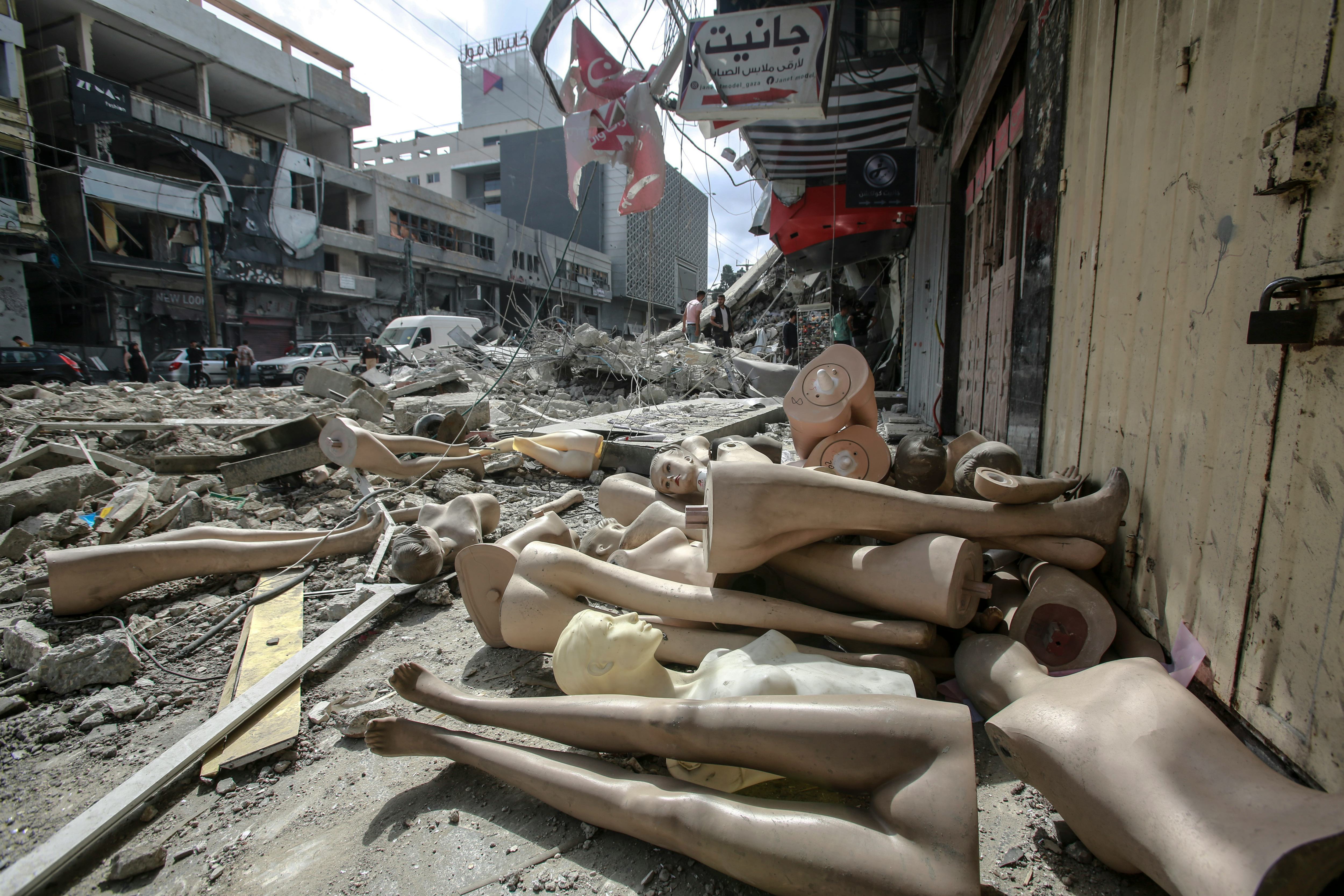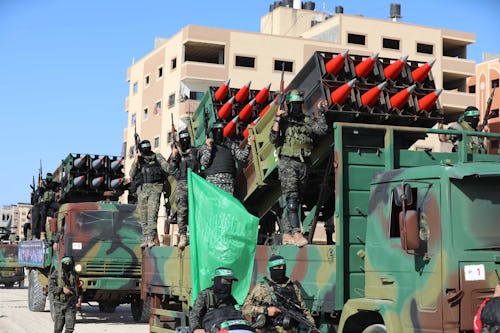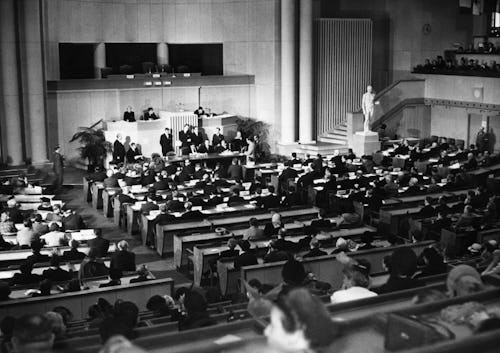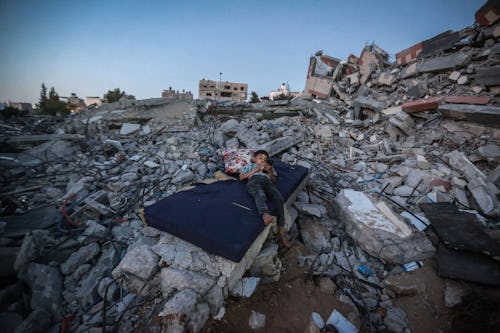
Over the last few weeks, a new round of intense, open violence erupted in the longstanding Israeli-Palestinian conflict. And with it came a deluge of brutal accounts, often accompanied by video footage, of civilian displacement, destruction, and death: Missiles fired into residential buildings; vital infrastructure, like roads and hospitals, gutted; tens of thousands of people sheltering wherever they can, many in a state of increasing precarity.
A ceasefire agreement, reached at the end of last week, slowed the flow of these horror stories. But it will almost certainly only be a temporary reprieve, as there is no end to the wider conflict in sight.
Confronting these sorts of human tragedies triggers many observers’ natural sense of empathy and justice, says David Crowe, an expert on international criminal law. That leads them to feel the need to express just how wrong it is to subject innocent people to the chaos of modern warfare, and to demand accountability for the propagation of widespread suffering. And often, the easiest way to do that is by labeling acts that lead to civilian suffering — like the rocket strikes conducted by the Israeli government, and to a lesser degree Hamas, in recent weeks — as war crimes.

It’s a forceful phrase, as it both evokes a sense of blatant and extreme wrongdoing, and demands meaningful punishment and restitution. But as Crowe, who literally wrote the book on the history of war crimes, and several other experts Mic consulted for this article pointed out, it’s also a legal term. Few laypeople know what technically constitutes a war crime, these experts added, which leads frequently to dissonance between colloquial and official uses of the label.
So, it’s worth clearing up — in detail — what war crimes actually are, and how the label gets assigned.
The birth of “war crimes”
Although societies have sporadically attempted to regulate war since at least antiquity, broad agreement on the rules of warfare, centered on a vague desire to protect civilians and other non-combatants from its harms, only started to emerge in the West in the mid-19th century. The term “war crimes” itself was only coined in English in 1906. Yet even into the 1940s, the exact definition and legal contours of the term were still a bit hazy. Until World War II, it fell to individual states to enforce these broad norms in most cases. And they often granted their own citizens a wide degree of leeway when they committed atrocities — and complete immunity if someone in government ordered them to do so.
But when the scope and scale of atrocities committed by Axis soldiers and officials came into focus, it prompted the Allied powers to set up international tribunals to make sure the perpetrators of war crimes were punished via systematic application of justice, regardless of their nationality, status, or orders they may have received. The trials forced Allied powers to cobble together a concrete and workable list of prosecutable war crimes, drawn mainly from the still-nebulous world of international treaties.
But because this list was still a bit ad hoc, the trials’ primary legacy was enshrining the ideas that there could and should be a universal set of standards for war conduct, that any transgression against them would be war crimes, and that the entire world ought to be obligated to police violations of these rules.

In 1949, the fourth Geneva Convention finally laid out a comprehensive list of rules for conduct during armed conflicts and established that any violations of these rules would merit prosecution as war crimes. The Convention actually initially called violations “grave breaches” rather than “war crimes;” a 1977 update to the Convention clarified that the two terms are, as everyone had long assumed, synonymous. Every nation has signed onto the 1949 list, thus establishing it as the definitive, universal enumeration of war crimes.
Okay. So then what is a war crime, specifically?
The Geneva Conventions call civilians — and combatants who are sick or injured, are prisoners of war, or have surrendered — “protected individuals.” War crimes, meanwhile, are defined as “willful killing, torture, or inhuman treatment, including biological experiments, willfully causing great suffering or serious injury to body or health” against these “protected” people. Arbitrarily deporting or otherwise displacing, conscripting, or denying fair trials to these individuals also constitute war crimes, as do hostage-taking and excessive destruction or pillaging of property.
Later widely accepted international treaties, like the 1998 Rome Statute that established the International Criminal Court, adhered to the Geneva Conventions’ overarching definition of war crimes. The difference is that they often offer more specific definitions — for example, specifying that taking sex slaves, forcibly sterilizing people, and conscripting child soldiers all fall under the umbrella of inhumane treatment.
International law firmly holds that war crimes can only occur during wars, James Gow, a professor of international peace and security studies, tells Mic. This may seem self-evident, but it’s important: It means the same general atrocities, when committed outside of war, cannot be prosecuted as, and lead to the sanctions associated with, designated war crimes. These acts instead have to be categorized as “crimes against humanity or genocide, which are discrete categories with their own specific characteristics and requirements,” Gow explains.
“That leads to the question: Well, what is a war?” Crowe says. “Does it have to be a declared conflict between two states — traditional warfare? Does it apply to conflicts within a country, or with terrorists?”
Since the 9/11 terrorist attacks, the United States has notably argued that most acts of terrorism fall beyond the scope of the Conventions, and that this in turn gives the country wide discretion in how to deal with terrorists.
The 1977 addendum to the Geneva Conventions does specify that these protections extend to combatants in internal and non-traditional conflicts. But nations still occasionally attempt to argue that certain forms of violence don’t rise to the level of treaty-covered armed conflict, and that certain irregular combatants fall outside of the Conventions' protections. Since the 9/11 terrorist attacks, the United States has notably argued that most acts of terrorism fall beyond the scope of the Conventions, and that this in turn gives the country wide discretion in how to deal with terrorists. The U.S.’s “unlawful combatants” designation, which explicitly argues that an individual is not covered by the Conventions, is the cornerstone of America’s justification for its forays into torture, indefinite detentions, and any other number of actions in the war on terror that sure seem like war crimes to many observers.
Why some wartime atrocities aren’t technically “war crimes”
The Conventions do hedge their protections with ambiguous modifiers like unnecessary and excessive. Lt. Col. Durward Elton Johnson, an expert on international law at the U.S. Naval War College, tells Mic that this stems from an acknowledgement at the heart of international human rights laws: “That a state whose actions comply with the letter of the law governing armed conflict might incidentally result in loss of civilian life or property, even though the state seeks to avoid, or minimize civilian harm as much as feasibly possible.” (Johnson stressed that he spoke to Mic in a personal capacity, not as a representative of the military or any other state entity.)
International law holds that combatants have to attempt to make a distinction between combatants and non-combatants in the field; that they must take precautions to avoid or mitigate the harms their actions cause to non-combatants; and that they must have a good argument that the potential impacts of their actions are proportionate to the military benefits they stand to gain from them. But when conflicts occur in populated urban areas, or involve combatants with a penchant for embedding themselves among civilians (like Hamas), this creates ample room for officials to argue that they just had to do horrible things to achieve military goals they claim to be legitimate.

“In the [recent Israeli-Paestinian] military conflict,” war crimes historian Michael Bryant explains, “the Israelis have been accused of war crimes for bombing buildings that housed innocent civilians, including women and children. The Israelis have defended their actions as a lawful response to Hamas using such buildings as sites for firing missiles into Israel. On this theory, the Israeli bombardment of civilian targets is legal, because their target isn’t noncombatants but Hamas.”
Who designates and prosecutes war crimes?
The Geneva Conventions compel every nation in the world to “search for persons alleged to have committed, or to have ordered to be committed” war crimes, and to prosecute them if they can. And many do: Notably, America held its soldiers accountable for murdering dozens of civilians in the Vietnamese village of My Lai in 1968, and last year Australia laid out a huge case implicating its elite troops in Afghanistan in a longstanding pattern of war criminal conduct.
However, states often turn a blind eye to potential war crimes that would be inconvenient or embarrassing to investigate. (See: America’s reticence to hold former President George W. Bush accountable for his administration’s many shady military moves.) And weak states, especially those dealing with the aftermath of major conflicts, often lack the resources to pursue war crimes cases.
But even if some states are unwilling or unable to tackle their own war crimes, the international nature of these infractions opens the door for other states to use what’s called universal jurisdiction to launch trials, even against people who are entirely unrelated to their land or citizens. The international community also sets up independent tribunals in the wake of major regional conflicts to help shattered nations prosecute cases. In 2002, most of the world’s nations agreed to set up the International Criminal Court, a permanent tribunal to serve as a last resort for trying cases that other nations can’t or won’t. Any member nation can refer war crimes allegedly committed by its citizens or within its jurisdiction to the ICC for investigation.

However, international courts often struggle to get the nations whose combatants they’re investigating to cooperate. America, which never fully signed onto the ICC, has notably balked at the ICC’s attempts to investigate its military actions in Afghanistan.
What’s more, it is often incredibly hard to prove to any court that a war crime was intentionally committed, beyond any doubt. “You have to get into the mind of the commander to prove that,” says Gary Solis, a Vietnam War veteran, longtime professor of the law of war, and former military prosecutor who has successfully pursued war crimes cases against numerous U.S. soldiers. “In fact, very few people have even been tried for proportionality offenses outside of the [World War II war crimes] tribunals.”
That’s why officials usually only slap the “war crimes” label on relatively small-scale incidents, in which there’s abundant evidence that non-combatants clearly suffered or died under incredibly egregious circumstances. As Bryant noted, the only slam-dunk court cases involve “deliberate, cold-blooded killings of civilians, devoid of military justification.”







